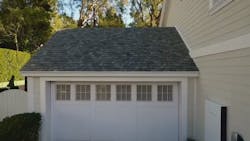Elon Musk unveiled a new "solar-roof" product at Universal Studios in Los Angeles, CA—another action to showcase his ambitions to make Tesla Motors a clean-energy behemoth, according to Bloomberg. Musk told hundreds of guests gathered in an outside courtyard on the "Desperate Housewives" set that Tesla (Palo Alto, CA) and SolarCity (San Mateo, CA), the company that he chairs and which he aims to acquire, will make solar roofs—a form of building-integrated photovoltaics or BIPV—that look better than normal roofs. He then showcased several houses with solar tiles gracefully embedded; many guests in attendance could not tell that they were solar.
RELATED ARTICLE: Heliatek raises nearly $90M to expand thin-film BIPV solar production
"How do we have a solar roof that is better than a normal roof, looks better, last longer," said Musk. "You want to pull your neighbors over and say 'Check out this sweet roof'." Musk's presentation was short on details about the proven efficiency of the solar cells, the roof's warranty, cost, or when it will be available to customers. The solar roof will be offered in four styles: Textured Glass Tile, Slate Glass Tile, Tuscan Glass Tile, and Smooth Glass Tile. SolarCity's website says production will begin in mid-2017 and that the tempered glass is as "tough as steel."
"The solar roof consists of uniquely designed glass tiles that complement the aesthetics of any home, embedded with the highest efficiency photovoltaic cells," said Tesla in a statement. "Customers can choose which sections of their roof will contain the hidden solar technology while still having the entire roof look the same."
Paula Mints, chief market research analyst at SPV Market Research, questions the economics of the new offering, which can be combined with a home battery. "Tesla announced a solar tile—not new—with battery that is priced below cost," said Mints in an e-mail. "Basically Tesla announced another way to lose money."
The larger idea is that homeowners will generate electricity for their home with solar power, then store that electricity in a home battery known as a Powerwall. You can "fill up" your battery during the day, then discharge it at night when the sun sets. The latest product iteration, known as Powerwall 2, weighs 269 pounds and is designed to be floor- or wall-mounted inside or outside.
Musk and Tesla chief technology officer JB Straubel have long envisioned a clean-energy future of electric cars powered by an increasingly solar grid, with Tesla's batteries optimizing both. The company also offers much larger Powerpack systems to commercial and utility customers and has deployed almost 300 megawatt hours in 18 countries to date, according to a Tesla blog post.
Battery-based energy storage has the potential to revolutionize electricity for the world's poorest citizens in the way mobile technology disrupted the telecommunications industry. Coupled with solar panels or wind turbines, powerful lithium-ion batteries can store energy and provide electricity for the roughly 1.3 billion people worldwide who don't have access to electricity and face what's called "energy poverty."
Friday's event is part of an effort to make the case for the SolarCity acquisition to investors. More details, including financial information, will be revealed November 1, when Tesla has said it plans to "create a clear picture of how a combined Tesla and SolarCity will make solar and storage as compelling as electric vehicles." Bloomberg adds that the proposed merger has been controversial because Musk is the chairman and largest financier of SolarCity, and the boards of both companies are deeply intertwined. Shareholders are to vote on the proposed merger November 17.
SOURCE: Bloomberg; https://www.bloomberg.com/news/articles/2016-10-29/musk-unveils-solar-roof-shingles-at-los-angeles-event-friday

Gail Overton | Senior Editor (2004-2020)
Gail has more than 30 years of engineering, marketing, product management, and editorial experience in the photonics and optical communications industry. Before joining the staff at Laser Focus World in 2004, she held many product management and product marketing roles in the fiber-optics industry, most notably at Hughes (El Segundo, CA), GTE Labs (Waltham, MA), Corning (Corning, NY), Photon Kinetics (Beaverton, OR), and Newport Corporation (Irvine, CA). During her marketing career, Gail published articles in WDM Solutions and Sensors magazine and traveled internationally to conduct product and sales training. Gail received her BS degree in physics, with an emphasis in optics, from San Diego State University in San Diego, CA in May 1986.
